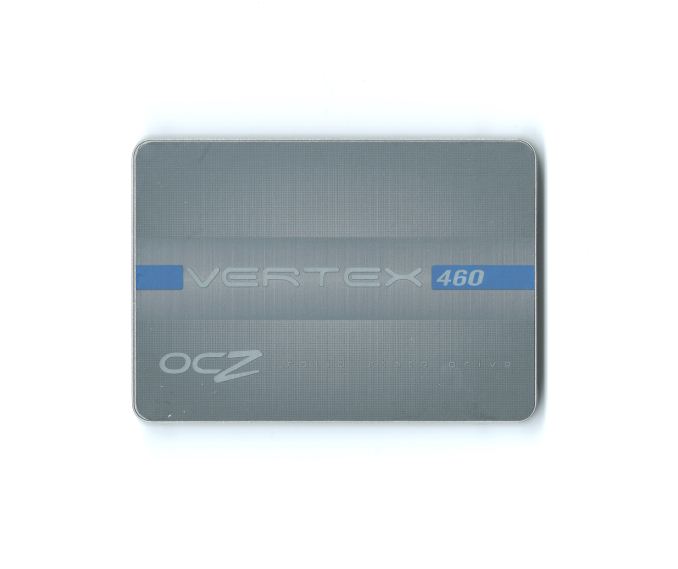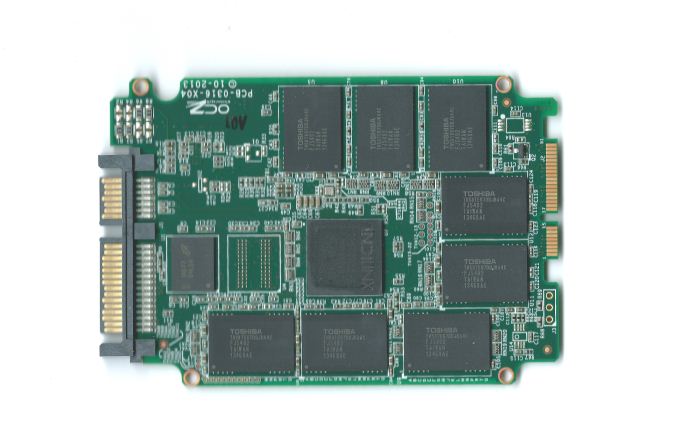OCZ Vertex 460 (240GB) Review
by Kristian Vättö on January 22, 2014 9:00 AM EST- Posted in
- Storage
- SSDs
- OCZ
- Indilinx
- Vertex 460

The last few months have not been easy at OCZ. After long-lasting financial issues, the company filed for bankruptcy on November 27th and a week later Toshiba announced that it will be acquiring the assets for $35 million.
Yesterday OCZ announced that the acquistion has been completed and were finally able to shed some lights to the details of the deal. To my surprise, OCZ will continue to operate as an independent subsidiary and won't be integrated into Toshiba's own SSD team. I'm guessing Toshiba sees financial potential in OCZ and is hence keeping things as they are. The only change aside from the change of ownership is a new brand logo and name: OCZ is now called OCZ Storage Solutions to further emphasize the focus of the company. Last time I heard OCZ was looking for a buyer for its PSU business but it seems they've not found one yet.
Update 1/31: We finally have an official statement regarding warranties.
Update 2/1: OCZ has a buyer for its PSU division and we'll have more details in a couple of weeks. The RAM and cooling divisions have been discontinued a long while ago, though.
| Comparison of OCZ's Barefoot 3 Based SSDs | ||||
| Vector 150 | Vertex 460 | Vector | Vertex 450 | |
| Controller | Indilinx Barefoot 3 | |||
| NAND | 19nm Toshiba | 19nm Toshiba | 25nm IMFT | 20nm IMFT |
| Over-Provisioning | 12% | 12% | 7% | 7% |
| Encryption | AES-256 | AES-256 | N/A | AES-256 |
| Endurance | 50GB/day for 5 years | 20GB/day for 3 years | 20GB/day for 5 years | 20GB/day for 3 years |
| Warranty | 5 years | 3 years | 5 years | 3 years |
The Vertex 460 resembles OCZ's flagship Vector 150 a lot. In terms of hardware the only difference between the two is that the Barefoot 3 controller in the Vertex 460 is slightly lower clocked than the one in Vector 150. The Barefoot 3 in the Vector 150 runs at 397MHz while in the Vertex 460 it's clocked at 352MHz. The speed of the controller isn't proportional to the overall performance but there are scenarios (like intensive read/write workloads) where a faster controller will help.
Both drives actually use exactly the same NAND (identical part numbers) but each Vector 150 goes through more testing and validation cycles to make sure the higher endurance criteria is met. Even though the NAND should be the same in both drives, bear in mind that endurance specifications are always minimums -- one part can be more durable than the other as long as both meet spec. By doing additional validation, OCZ is able to pick the highest endurance parts and use them in the Vector 150, whereas lower quality chips (but good enough to meet the mainstream endurance requirements) end up in the Vertex 460.
The choice of identical NAND in both models is indeed odd but I'm guessing that Toshiba had a hand in this. The Vertex 450 used Micron's NAND but obviously Toshiba doesn't want to use a competitor's NAND in their products, hence the Vertex 450 is replaced with the 460 and Toshiba NAND.
| OCZ Vertex 460 Specifications | |||
| Capacity | 120GB | 240GB | 480GB |
| Sequential Read | 530MB/s | 540MB/s | 545MB/s |
| Sequential Write | 420MB/s | 525MB/s | 525MB/s |
| 4KB Random Read | 80K IOPS | 85K IOPS | 95K IOPS |
| 4KB Random Write | 90K IOPS | 90K IOPS | 90K IOPS |
| Steady-State 4KB Random Write | 12K IOPS | 21K IOPS | 23K IOPS |
Similar to the Vector 150, the Vertex 460 switches to 12% over-provisioning. This seems to be an industry wide trend and to be honest I'm happy with that. The few percents extra makes a huge difference in terms of IO consistency, which in the end accounts for a better user experience.
Test System
| CPU | Intel Core i5-2500K running at 3.3GHz (Turbo and EIST enabled) |
| Motherboard | AsRock Z68 Pro3 |
| Chipset | Intel Z68 |
| Chipset Drivers | Intel 9.1.1.1015 + Intel RST 10.2 |
| Memory | G.Skill RipjawsX DDR3-1600 4 x 8GB (9-9-9-24) |
| Video Card | Palit GeForce GTX 770 JetStream 2GB GDDR5 (1150MHz core clock; 3505MHz GDDR5 effective) |
| Video Drivers | NVIDIA GeForce 332.21 WHQL |
| Desktop Resolution | 1920 x 1080 |
| OS | Windows 7 x64 |
Thanks to G.Skill for the RipjawsX 32GB DDR3 DRAM kit












69 Comments
View All Comments
Kristian Vättö - Wednesday, January 22, 2014 - link
All OEMs do cherry-picking, so blaming OCZ is useless. However, in SSDs it doesn't matter that much because NAND is binned for endurance, not performance. While there can always be minor differences in performance between units, it's nowhere near as big as in e.g. CPUs.As for buying review samples, that would not be financially efficient. Consumer Reports and the like are different because they're funded by the government or other huge organisation, whereas we are private. Furthermore, we wouldn't be able to deliver reviews on time for release because we'd have to wait for retail availability like everyone else.
FunBunny2 - Wednesday, January 22, 2014 - link
I can 'buy' the second reason, but Anand can't afford a $300 SSD? Come on.bhaberle - Wednesday, January 22, 2014 - link
So you are telling me you would be okay with spending at minimum, tens of thousands of dollars on parts? Sure that is just ONE $300 SSD. What about about the other 15+ that they would need to get. Be realistic. If it is not a big deal, why don't you go buy that many. Sure they make money with this site, but it would take some time just to break even on the costs of the parts even for a large site like Anandtech. If you don't appreciate the effort they put in their reviews then stick to consumer reports.blanarahul - Wednesday, January 22, 2014 - link
That's what I said.BTW, can you guys test Samsung XP941?? And if possible, a comparison with 2 840 Pros in SLI.
Uhh. RAID..
Kristian Vättö - Friday, January 24, 2014 - link
I asked Samsung for a sample a while back but they wouldn't send us one since it's an OEM-only product. However, Anand got a pair of XP941s in the new Thunderbolt 2 equipped LaCie drive... ;-)henrybravo - Wednesday, January 22, 2014 - link
Great comment. Blame company PR, not Anandtech.PEJUman - Wednesday, January 22, 2014 - link
I own various branded SSDs, Intel, OCZ, Corsair to name a few.Some fails some don't (yes, even my intel X25-M G2 failed me at one point).
In the end, Anandtech readers are typically smart enough to run backups so any failures like that is not a big deal.
I form my own price/performance/risk assesment:
I use newegg, amazon, slickdeals, camelx3 for price.
Anandtech, Toms and forums for performance.
and lastly verified buyer comments at newegg & amazon for risk.
I could care less about a brand or what color is the box of my CPU/GPU.
MrSpadge - Wednesday, January 22, 2014 - link
And some people are obsessed with hating OCZ. Sure they made several mistakes, some not directly related to their technology. But that happened years ago. Sit back and see how the new drives developed in coorporation with Toshiba work out. Judge those drives by what they are, not what their grand-grandfathers were.Bob Todd - Wednesday, January 22, 2014 - link
You make it sound like all of their problems with quality control and high failure rates happened in the ancient past. This site's Vector review sample died during testing less than 3 months ago. I'm on my 3rd Agility 4 after RMAs and this one needs to go back too. That drive only came out ~18 months ago. I'd be happy to embrace a new wave of OCZ SSDs that were reliable, but we won't know how well (or if) they've managed to turn things around until we get several models in consumers hands and have adequate time to judge reliability.Roland00Address - Thursday, January 23, 2014 - link
OCZ has made plenty of shitty ssds in the last 3 years. I will be happy to buy a OCZ/Toshiba SSD but not until they have a track record of 3 good years for their ssds.Why deal with the head ache of your computer going out or your data corrupted just to save $10 or $20 dollars?